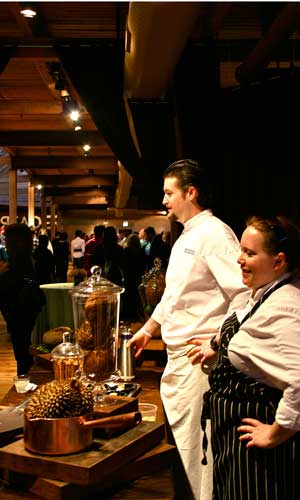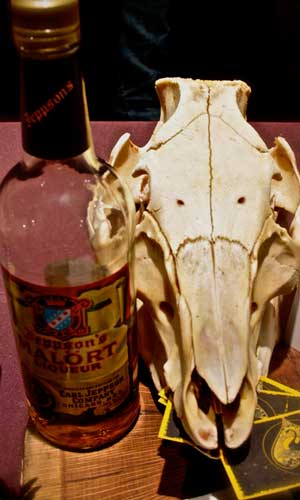Photo Credit: Alyssa Stone
I don’t need to dress nice, right? Alyssa texted me as I got on the Pink line. I looked down at my scuffed boots, the jeans I’d been wearing for two or three days, and the T-shirt that could be called, at best, relatively clean. Or so it had been when I’d picked it up off my floor that day.
Hope not, I texted back. I’m in jeans and a dirty t-shirt. I was on my way to the Key Ingredient Cook-Off directly from my job at a bookstore, and there was no time for me to stop at home and change. My Friday nights are often an unwinding ritual of takeout, beer and enjoyably bad movies. This week, however, I had gallantly offered (read: begged) to go to the Key Ingredient Cook-Off.
Key Ingredient is a James Beard Award-winning column in the Chicago Reader. Each week, one Chicago chef challenges another to make a dish using some strange, rare, gross ingredient: this week, Jonathon Zaragoza dared John Asbaty of Panozzo’s Italian Market to do something with honeycomb tripe. On May 3, the Reader hosted a cook-off of epic proportions, inviting 26 of Chicago’s best and brightest chefs to try and make something amazing out of something sort of gross.
 Though I never found any kind of pamphlet or program, I sussed out that the 26 chefs participating in the cook-off had been assigned one of five ingredients: durian, celery, millet, Malört and dried shrimp. With the exception of Malört, these are all ingredients that are commonly used in cooking, though some are less common in North America. They do, however, all have flavors or textures that make them a little bit edgy. Durian, for example, smells and tastes like a mixture of ripe feet, honey, sewage and onions. Malört, as I found out, tastes like every medicine that you would have cried before swallowing as a child.
Though I never found any kind of pamphlet or program, I sussed out that the 26 chefs participating in the cook-off had been assigned one of five ingredients: durian, celery, millet, Malört and dried shrimp. With the exception of Malört, these are all ingredients that are commonly used in cooking, though some are less common in North America. They do, however, all have flavors or textures that make them a little bit edgy. Durian, for example, smells and tastes like a mixture of ripe feet, honey, sewage and onions. Malört, as I found out, tastes like every medicine that you would have cried before swallowing as a child.
When Alyssa and I got inside, I was starting to wonder if maybe we should have dressed up. We were greeted by men in ties escorting guests into a huge freight elevator. I glanced around: we were’t the only ones in jeans and cardigans, but there were more than a few glammed-up gourmands. It was an interesting mix of older folks in cardigans and sensible heels and the hip and the restless in smoking jackets and retro dresses. There were a lot of serious people there, who admired my foresight in taking notes about each dish and a lot of people who were flippant in their love for food and foodie culture (I’m looking at you, Dude in the Crazy Smoking Jacket).
We entered the top floor to the sound of remixed Leonard Cohen’s “Take a Walk on the Wild Side,” which I took as both a good sign and good advice. I immediately challenged myself to try one of everything, knowing full well I would fail. Within half an hour, I had eaten dried shrimp brandade with chanterelle mushrooms and foraged ramps, durian crème brûlée, frog salad with pickled quail’s egg and green curry relish and pig tripe and bone marrow sausage and pickles served in a nasturtium leaf.
I have something of a restraint problem at these kinds of things. Scofflaw was offering free cocktails (“Feel free to get hammered!” one of the bartenders said as he passed over my and Alyssa’s drinks.) And everywhere, chefs were pretty much shoveling food at passersby. By the end of the night, my notes were littered with stains and water rings from where I set my drink down on them.
Most of the chefs tried to walk a fine line between showcasing their ingredients and not blowing people’s taste buds. Considering the talent there, a few chefs made some weirdly uninspiring dishes: one served up a creamy celery soup with lamb. It was good, something I’d happily eat under most circumstances, but…soup? Where’s the fun in that?
 The folks competing in the Malört category seemed to have this problem as well, adding Malört to deserts and barbecue sauce that mostly hid its signature bitterness. Or so it seemed to me: despite having heard rumors and tales of the drink since I moved to Chicago, I had never actually tried it, and I wasn’t sure what to look for. To get some info on the infamous liqueur, I went over to Three Aces‘s table, staffed by Matt Troost and another guy whose name I completely failed to get. I chose their table based on the name of their dish: “Malört face,” thin slices of pig face braised in Malört, with Malört mustard and Malört-ramp vinaigrette. Also, their display bottle of Malört was half empty. It was a good choice.
The folks competing in the Malört category seemed to have this problem as well, adding Malört to deserts and barbecue sauce that mostly hid its signature bitterness. Or so it seemed to me: despite having heard rumors and tales of the drink since I moved to Chicago, I had never actually tried it, and I wasn’t sure what to look for. To get some info on the infamous liqueur, I went over to Three Aces‘s table, staffed by Matt Troost and another guy whose name I completely failed to get. I chose their table based on the name of their dish: “Malört face,” thin slices of pig face braised in Malört, with Malört mustard and Malört-ramp vinaigrette. Also, their display bottle of Malört was half empty. It was a good choice.
“I wanted to put [the dish] on plates with pictures of people’s Malört faces,” he told me, “but couldn’t find a printer to do it.” Troost is a Malört evangelizer, and he described it as “your taste buds getting punched in the balls,” a paraphrase off of the official Malort slogan of “It will kick your mouth in the balls.” His cohort was more poetic: “It tastes like calling your ex in the middle of the night from a phone booth in the rain.” Which is to say, it’s bitter. You start to regret it before you even finish swallowing it, but there’s nothing to do but power through the pain.
While there were many good dishes at the cookoff, ones that I would happily eat again, they often seemed to work by pushing the assigned ingredient into the background. The one exception was from Marianne Sundquist at Mess Hall and Co. She created a tiny white-chocolate candy filled with frozen celery mousse and a sherry-soaked raisin. I bit into it, not sure what to expect, and was shocked at the burst of celery flavor. It was incredibly delicate, both the dish itself and the tastes that worked in conjunction with each other.
The ballsiest dish, by far, came from Fat Rice’s Abraham Conlon, who used all five ingredients, and for shits and giggles, added in epoisses, a French cow’s milk cheese that has a washed rind and is smear-ripened. It’s an awesomely rank cheese. Conlon made durian epoisses with a shrimp and Malört rind, making a gooey, creamy mixture to spread over the toasted millet bread, and topped it with a celery and grape salad.
The weirdest thing was how well Conlon’s concoction worked. The crisp texture and the bright acidity of grapes and celery balanced out the intense flavors of the cheese and durian, but it was still intense, about as subtle as bludgeoning someone with a brick. “It’s like a horror movie,” I drunkenly slurred to Conlon. “Have you seen the remake of Evil Dead? It’s like that. It’s amazing, but I never want to do it again.”
I meant it as a compliment. I think Conlon got that, because he started telling me about a movie called Hobo With a Shotgun before he got called away again. I looked up the trailer for it, and yeah. It’s exactly like that. A work of art, but not the kind of pleasant art that goes up in a bank or boutique cafe. The flavors and textures of these ingredients aren’t easy on the sensibilities of privileged Westerners. They’re violent on the palate.
Western aesthetics, until very recently, were mostly focused on things that were pleasant, non-disruptive, and yearning after some kind of lost paradisaical ideal. Think about the kind of vocabulary used in food writing: heavenly, glorious, sublime, ambrosial. Durian, Malört, dried shrimp: these aren’t the nectars of gods. They’re flavors that are firmly of the earth (or sea, in the case of dried shrimp). There’s an echo of something primal.
I think what I was drunkenly trying to tell Conlon is that his durian epoisses inspired the same heights of emotion as Hobo With a Shotgun is bound to do. I may cringe, cover my eyes, wince in sympathy, but I’m fully present during the show, and the inner monologue that carries on in my mind–reciting my to-do list, analyzing social interactions, pondering random memories–competely ceases. All I’m doing is experiencing the movie, uttering profanity without regard to who might hear, because sometimes, a good “Holy fuck!” suffices when all other words fail.
When I smeared the orange-tinted epoisses onto the tiny slices of millet bread and topped it with thin slices of celery and grape, when I slid it into my mouth, as careful as if it were a live explosive, it was like the entire room went quiet. I chewed, and all I could think was holy fuck, HOLY FUCK.